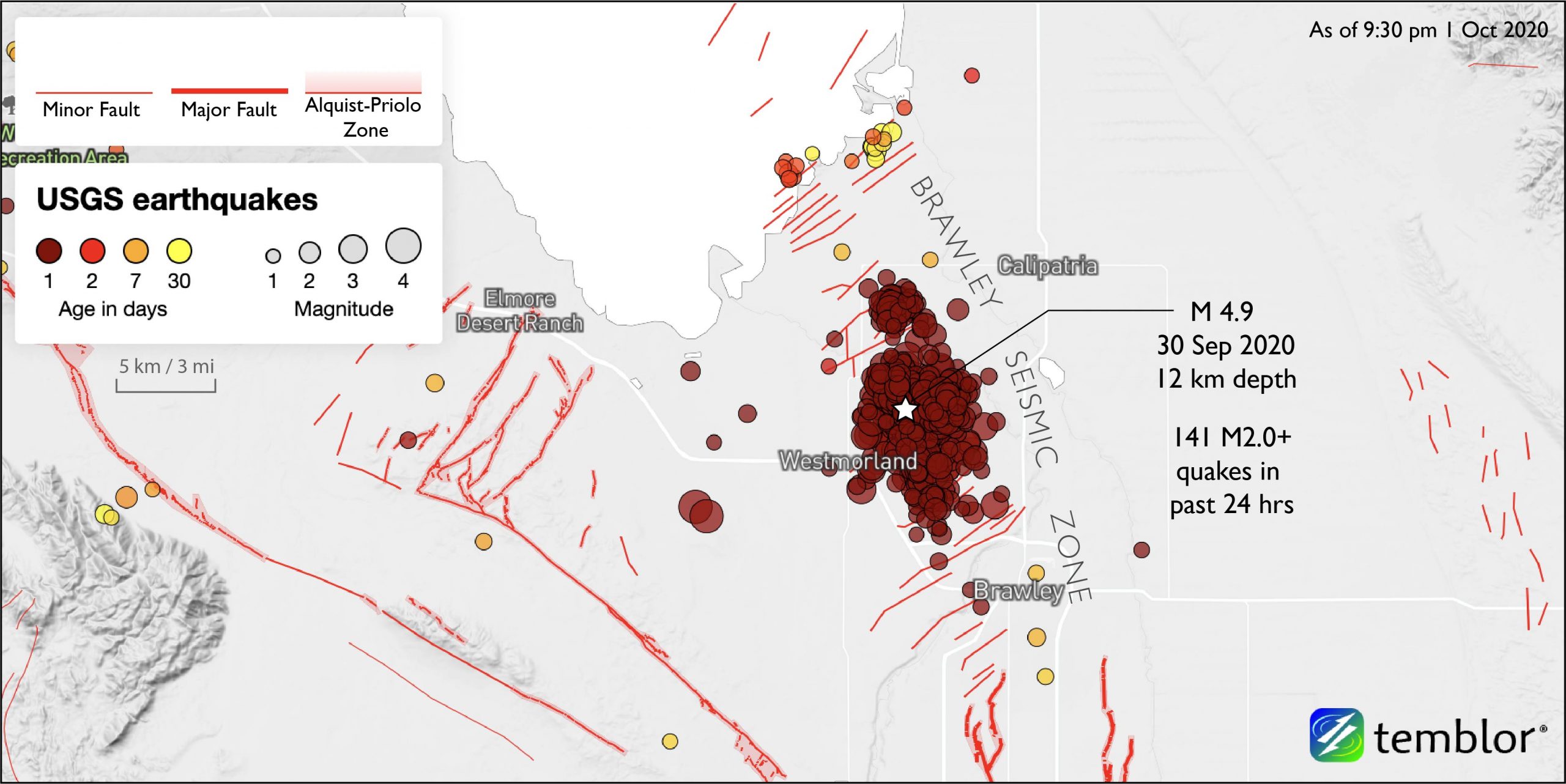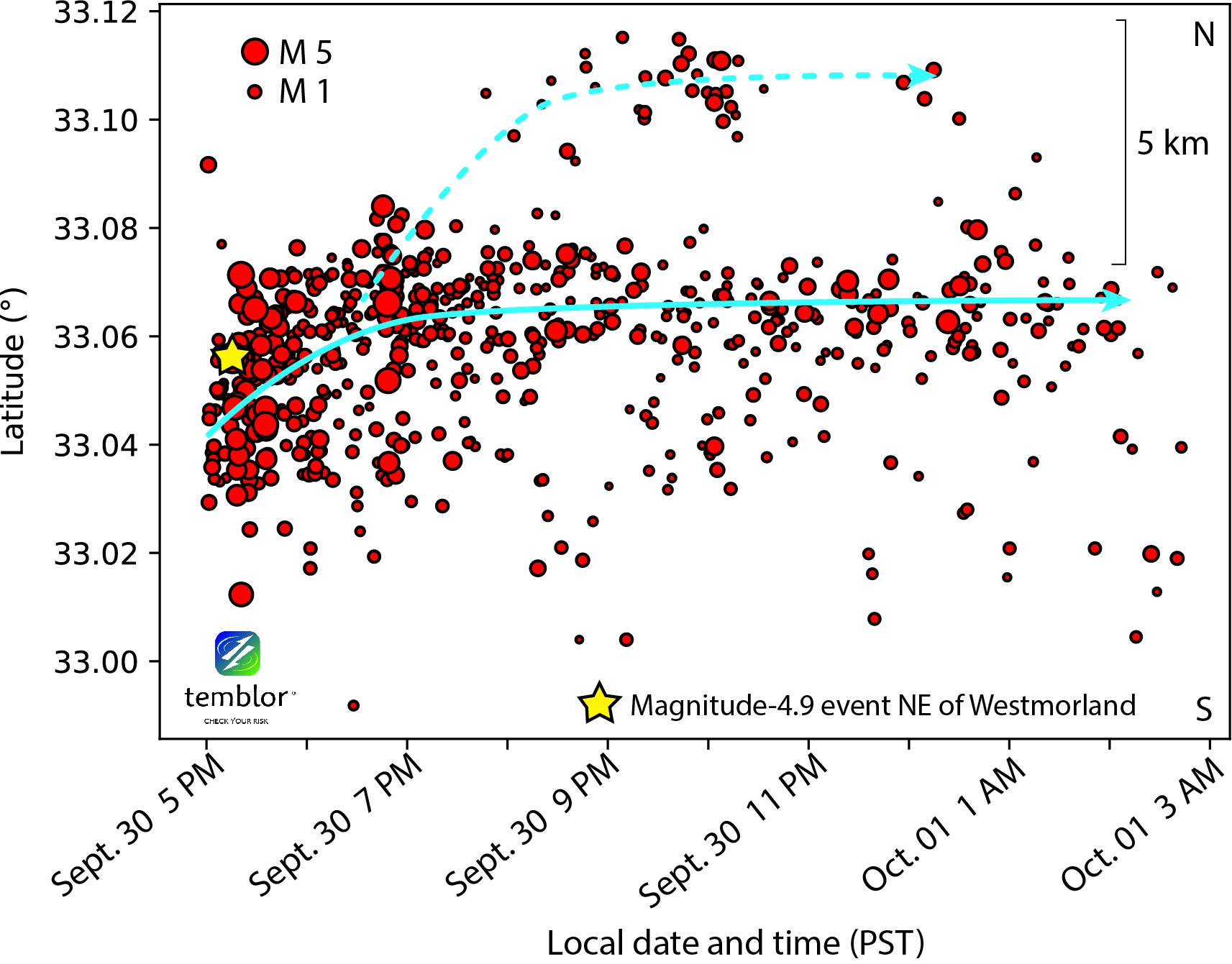Came across this item as it makes clear that in earthquake country, that many locales produce swarms of tremblors that cause little damage and certainly releasee strain.
Eathquake prediction has been mostly a study of primary known locations on main faults. Actually this is pretty primitive.
In Vancouver, we have complex geological environmnet that supports the following:
1 We are clearly bounded by the Descending Pacific Plate west of us on the other side of Vancouver Island.
2 south of us we are bounded by the Juan de Fuca E/W Fault.
3 Both have produced huge events. Yet Vancouver Island acts like a giant ballast for both and the city of Vancouver is largely protected. This is confirmed by the lack of fault tears anywhere.
4 We do get deep as in sixty mile down subduction tremblors under the Salish Sea. Rare enough actually as i remember one I felt.
My point is that just a simple look at the 3D picture along with surface evidence adds up to a much better understanding for all local interpretaion. We need to see a lot of this. Recall that we did not feel Anchorage while plenty south of us did. In fact we never feel any of the not so minor quakes taking place west on the otherside of Vancouver Island.
Japan does the same for its west side.
California’s Salton Sea rumbles again
POSTED ON OCTOBER 1, 2020
BY TEMBLOR
An earthquake swarm south of the Salton Sea fired off hundreds of quakes in the past 24 hours, including a magnitude-4.9 jolt felt as far away as San Diego.
By Alka Tripathy-Lang, Ph.D (@DrAlkaTrip)
Citation: Tripathy-Lang, A., 2020, California’s Salton Sea rumbles again, Temblor, http://doi.org/10.32858/temblor.121
The Salton Sea. Credit: Matic Kozinc
For two days in August, the area around the Salton Sea shook as a swarm of earthquakes rollicked along faults beneath the water. After this burst of seismicity, the earth calmed to its usual — albeit jittery — state in the restive region that sits only 8 miles (less than 13 kilometers) from the southern tip of the San Andreas Fault. Yesterday, the quiescence ceased when tiny tremors began anew, this time centering on Westmorland, a small town south of the Salton Sea and several miles northwest of Brawley. The largest of these quakes, a magnitude-4.9 event, struck shortly after the swarm began, at 5:31 p.m. local time. Felt reports streamed into the U.S. Geological Survey (USGS) from across San Diego in the west to as far east as the Arizona-California border.
The swarm
The Westmorland Swarm is rattling through the Brawley Seismic Zone, “a fairly active part of the southern California plate boundary area,” says Zachary Ross, a seismologist at Caltech. This zone links the San Andreas Fault, which traverses much of California, to the Imperial Fault, which slices across the US-Mexico border. This area, he says, has hosted several swarms like the current one.
141 earthquakes have struck near Westmorland, California in the past 24 hours. Credit: Temblor
The USGS has reported hundreds of earthquakes greater than magnitude-1.0 since the swarm commenced yesterday. “There were about 40 earthquakes above magnitude-3.0 last night,” says USGS seismologist Morgan Page. However, the swarm appears to be settling, with a much lower rate of earthquakes today. “There’s been [only] four magnitude-3.0 and higher earthquakes in the first seven hours of today compared to 40 in the last seven hours of yesterday,” Page explains.
To estimate how long this swarm may go on, Page says she and other seismologists look to the past history of swarms. “The August swarm only lasted two days,” she says, but elaborates that previous swarms have ranged from one to 20 days. The current swarm could kick up to a higher rate, she says, even as it seems to be dying down.
Moving along
With more than 600 magnitude-1.0 or larger earthquakes reported by the USGS so far, patterns may start to emerge. For example, by plotting latitude versus time, some smaller quakes appear to be moving northward, closer to the Salton Sea.
Time series showing date and time in Pacific Standard Time on the x-axis and latitude on the y-axis. North and South are labeled on the right. Each red circle signifies an earthquake, scaled by size. Star indicates magnitude-4.9 earthquake. Light blue curves indicate apparent spatial migration of the swarm that seismologists will likely investigate as they carefully analyze each event in the near future. Credit: Geoffrey Ey, Temblor
Ross, however, cautions that earthquake information calculated in near real-time gives only a preliminary location for each event. He says, “Getting a better constraint on the location requires more computationally intensive processing, and that’s not something we do in real time.” In other words, we’ll have to wait and see if any apparent migration of these temblors passes muster.
USGS earthquake forecast
“These types of sequences are very complicated to forecast,” says Ross. Nevertheless, as the USGS did with the August Salton Sea swarm, they’ve issued an earthquake forecast that breaks down the probability of whether these small earthquakes might lead to bigger ones. This seven-day forecast, originally released last night, but updated this morning to reflect ongoing activity, describes three possible scenarios, each less likely than the last, for the next seven days (October 1-8).
In the most likely scenario, earthquakes will continue with events possibly as large as magnitude-5.4. Moderately-sized earthquakes — from magnitude-4.5 to 5.4 — could cause local damage.
In a much less likely scenario, a larger earthquake between magnitude-5.5 and 6.9 could occur within the week. Earthquakes in this magnitude range would certainly cause local damage. The USGS puts this probability at 1 out of 10. Although this scenario does not have a high likelihood, the 1981 Westmorland Swarm included a magnitude-5.8 event.
In the least likely scenario, approximately 1 in 300 (less than 1%), a much larger earthquake of magnitude-7.0 or above could strike. Such an unlikely event would cause serious damage in Southern California.
Location, location, location!
The most significant difference between the August swarm and today’s may be the most obvious — location. “The swarm last August was a lot closer to the San Andreas Fault,” says Page. She explains that though it is possible the current swarm could trigger an earthquake on either the San Andreas or Imperial faults, such an event is not extremely likely. She emphasizes this is especially true for the San Andreas, “as the swarm we had in August… was so much closer.”
As always, if you live in earthquake country, preparation is the most important step you can take. Prepare your earthquake kit, secure anything that can fall, and remember to drop, cover and hold on.
Further reading
temblor.net/earthquake-insights/over-66-million-people-participate-in-international-shakeout-prompts-evaluation-of-personal-preparedness-10051/
temblor.net/earthquake-insights/salton-sea-swarm-quiets-down-11571/



No comments:
Post a Comment